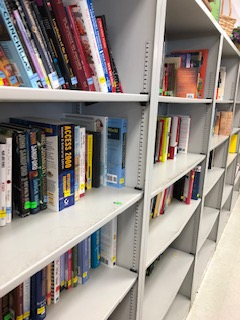"Idling," Short Story Published :)
Happy Halloween, Ya’ll! :)
Check out my romantic-suspense themed short story, “Idling,” out today at SunLit Story Time.
Photo Courtesy of Hugh McCann, unsplash.com
It's Publication Day! :)
It's my book birthday! Welcome to the world, Poetry Power!
Photo courtesy of Kyle Head at unsplash.com
My subtitle says it all: “An Interactive Guide for Writing, Editing, Teaching, and Reflecting on the Life Poetic.”
Write poetry? You know you need some new prompts. Teach? Your students will thank you for this advice and for the publishing tips. Have some poet friends in your workshop or writing group? I hear that their birthdays and the holidays are just around the bend.
Signed copies available (pm me).
Ebook and tactile copies available at Amazon and Vine Leaves Press.
Exciting Spring Class! Register Now-- Photography for Writers :)
I’m happy to announce that I’ll be teaching my four-week Photography for Writers class again this spring.
Beginning on April 5, 2019, this class is tremendously fun and a great way for writers to sharpen their photography muscles and vice versa. No photography experience necessary, and you can use whichever kind of camera (including camera phone) you’d like.
For more details and to sign up to reserve your spot in this cool online workshop now, please visit: Imagery Power: Photography for Writers. Feel free to message me with any questions.
Photo courtesy of Alfonso Reyes, https://unsplash.com
Featured Artist Today :)
Guess who’s the featured photographer today over at Fourth & Sycamore. Check out this still-life photo from my “In the Green” series.
Remembrancer2
Nikon camera shot, courtesy of Joseph Chan at unsplash.com
"How Sweet it is: Writing Resonant Flash Prose"
My craft article was published as a spotlight today at Women on Writing. If you’re interested in writing more flash, check out my online class that starts on November 2nd. :) In a Flash
“How Sweet it Is: Writing Resonant Flash Prose”
By: Melanie Faith
When I was a kid, my dad used to stop on the way home from work each night to get the newspaper for my mom and a candy treat for me and my sister. One of our favorite treats was wrapped in a long, thin piece of see-through cellophane. Inside, was a string of thick white floss that had elasticity, and strung along this floss were shiny, bright candies. These circular gems, in popping pastel shades of yellow, pink, orange, and blue, were vaguely-sweetened like fruit and floral flavors (the yellow was slightly tart yet banana-ish and the blue, I recall, tasted like a cross between raspberry and the way a rose smelled).
Each candy bead had the kind of brittle crunch that a child relishes—chomp-chomp!—but which would make my adult teeth weep. The hues of the candies melted with each chomp until the string was bare and vaguely pinkish-whitish-yellowish-blue-orange by the time the last candy was presto-change-oed. After just a few moments, the candy dye bled onto fingertips, tongue, and face, revealing opaque-white candies’ underbellies.
A vivid sense memory I repeat is the internal debate—holding the cellophane-wrapped treat, after a hug from my dad: should I rip into the cellophane immediately and wear the candy-pretty necklace (sometimes I doubled it around my wrist like a fancy lady’s bracelet)? Yet, there was the candy, so tantalizing, that who could resist just a tiny bite? On the other hand, once bitten into, the string was sticky and not really conducive to wearing—destroyed, in a sense, for displaying.
It was a catch-22, albeit one of the best kinds, and the tension between knowing when to hold onto something and when to begin was the kind of life lesson that doesn’t have a perfect answer and yet which gets repeated, unbeknownst to the child’s mind, again and again in life. Timing— whether strung on a string or not, whether involving choosing a major or a love interest or a house or a car or another job or having a child— is an infinite loop of weighing pros and cons and, eventually, just diving in. A lesson, as a Type A elder daughter, I struggled with endless times, weighing the sour against the sweet, second-guessing myself: Was it too soon? But could there be a too late? Even after the satisfying crunch, the soggy, lone string.
In the above flash nonfiction, I began with a simple note I’d jotted this morning in my writer’s notebook while still half-asleep and making my to-do list for the day. Idea: candy necklaces we ate as kids. Hours of student correspondence, errands, lunch, and dishes passed before I sat down again, opened my notebook on my desk and commenced to write the above passages.
Clocking in at just under 400 words, my creative process and this piece highlight some of the best facets of the flash genre. Let’s examine them:
· Flash begins with—well, a flash! Ever used a writing prompt? Sure, most of us have encountered them in writing classes, writing groups, and in books. The genius of a prompt is that it revolves around one idea. Good flash starts with a kernel of a topic which the reader then writes into in discovery. In the case of my candy-necklace flash, my random memory (which popped into my head after seeing a necklace online of white beads) became the prompt I explored.
· Flashes are focused. Notice above how I say “one idea?” In flash, there’s not room for asides or diversions. Any details about the rest of my childhood—the scented dolls I adored, the children’s jokes I loved to tell and invariably flubbed the punch lines of, have no place in this piece—they need to be moved to their own flashes. One is plenty in developing flash.
· Flashes are about what they are about, and they are also about something bigger than their subject, too. In other words: readers learn about you and your characters but they also learn something resonant about humanity. Sure, this is a flash centered on a personal memory, but it also has a theme that readers can connect with their own experiences: timing. How do we know when it is the right, or the wrong, time to do anything? The reader should walk away asking and connect to circumstances in their own past or present. Consider universal themes.
· It’s all about the imagery, baby! Without hitting readers over the head by spelling out theme, how can we explore themes and other literary language? One of the easiest ways is to develop imagery. Just like in poetry, another condensed form, flash nonfiction and flash fiction often employ plenty of sensory images to get the job done (as does this flash with taste, smell, auditory/sound, and visual imagery).
· Flashes include tension. Without the final paragraph of my flash, there wouldn’t be a lot of resonance or conflict in my piece. Most of the other paragraphs are a nice memory involving candy—perhaps interesting for my nieces to read or some other Gen Xer or Baby Boomer who remembers this type of candy, but not the stuff of literature per say. The final two paragraphs introduce the pressure of both leaning on one’s own internal judgment and the suggestion (without spelling it out) of external conflict/judgment over choosing something too soon or being too late to spoil the fun.
Try this exercise: Set a timer and write for fifteen minutes without stopping about a food associated with your own childhood. Incorporate at least three of the five elements of successful flash either as you write or when you return to edit your piece after writing.
Bookshop Interview :)
I had the great joy of participating in this Bookshop Interview at fellow author James H. Duncan’s website.
Check it out, along with James’s excellent books.
Goodwill Bookshelves, photos courtesy of Amanda McGrath
That Holding-First-Copies Feeling
Look what arrived, straight from my awesome publisher at Vine Leaves! I had to commemorate the moment with my new photo backdrop. ;)
I couldn’t be happier with the text and cover of my new craft book for poets, Poetry Power! One month and counting until publication day! #oct26thlaunch
More details at: Vine Leaves Press, Poetry Power . (The Amazon link for ordering in the States and abroad is at the site as well.)
What reviewers are saying: "Reading Poetry Power by Melanie Faith--chock-full of humour, personal asides, and sensible, doable suggestions to improve one's writing--I felt a continual urge to write and revise my poems. A perfect guide for the poet who wants a refresher course in the basics of this 'little genre' (and a few photography hints) from a new point of view and who needs a nudge to live more deliberately, Faith's book reminds me of an intimate conversation between two engaged introverts for whom layers of complicated interior depth--juxtaposed in the 'nooks and crannies' of dreams and fragments of memory--hold the key to discovery and development of a unique, artistic voice that rings with universality." Helen Losse, author of Every Tender Reed
"This is the definitive book on, for, and about poetry. Melanie more than delivers on the promise she made in the Introduction: This book is meant to reach you where you are and to withstand multiple readings as you explore your individual writer's path. Indeed! I find that no matter what funk I'm in, I open Poetry Power and I discover my next step on my poetry journey. I know my fellow poets will too!" Mari L. McCarthy, International Best-Selling Author of Journaling Power: How To Create The Happy, Healthy Life You Want To Live!
What reviewers are saying: "Melanie takes her readers by the hand and walks them through the whole process of writing, publishing, editing and loving poetry. Little personal vignettes scattered throughout Poetry Power made me feel like Melanie was a friend. It was as if we were in a writing group together and she was sharing her writing secrets. Each chapter ends with a Try this Prompt that are easy and exciting to try. They range from something that might take a few minutes, to others that were more involved. In my second, third, and so on readings of Poetry Power I will jump into the prompts with feet, hands and heart. I am already making a list of the people I will be purchasing a copy of Poetry Power for--and they include writers from all genres, not just poets. This is a book that all writers will benefit from reading." —Tricia L. McDonald, Writer and CEO Splattered Ink Press
Photography Publication, and It's a Peach ;)
The Sunlight Press just published another of my fine-art photos, “Ladder and Leftover Peach Triptych.”
They also featured a few paragraphs about the symbolism and the photo’s inspiration, among other things. Check it out.
Poetry Power: Update!
Hurry, fall! Next month, my poetry craft book will be released.
Super excited to share this volume packed with prompts and real-world writing, editing, and publishing advice with poets, teachers, writing groups, classes, and more.
My book birthday: October 26, 2018. You know you want one for you and the writing friends in your life.












